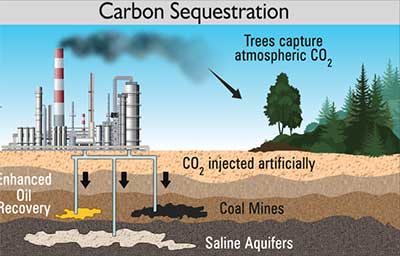GS 3- Conservation, Environmental pollution and degradation, Environmental impact assessment
Keywords- Carbon Sequestration, CCS( Carbon Capture and Storage) , CCUS( Carbon Capture Utilization and Storage) , IPCC Sixth report, accelerating CCS technologies(ACT) initiative, National Programme on CO2 Storage Research
Why in News?
A recent research, published by the Department of Earth Sciences, IIT Bombay, in an article titled ‘A systematic capacity assessment and classification of geologic CO2 storage systems in India’, asserted that the geological formations under India have potential to store at least 395 giga-tonnes (Gt) of carbon dioxide.
Research Findings: Different ways for Carbon Sequestration in India
- Carbon dioxide can be stored permanently in saline aquifers (porous rocks holding saltwater), depleted oil and gas fields, in coal seams and basalt rocks. Each of these has a different mechanism of holding the carbon dioxide, such as adsorption, compression and mineralisation.
- The researchers examined all the 26 sedimentary basins of India and determined that the country’s potential holds anywhere between 395 Gt to 614 Gt of carbon dioxide. India is estimated to emit around 2.7Gt of carbon dioxide every year. (One giga-tonne is one billion tonnes.)
- Coal seams are a good place to put back the CO2. Coal holds methane (also a greenhouse gas) -- hence coal-bed methane projects have great potential. But “coal has ten times more affinity for CO2 than for methane. “
- Basalt rocks (soft porous rocks), which essentially have silicates of elements like calcium and sodium, can easily take in CO2. The elements become their respective carbonates and remain there permanently – a mineralisation process.
- Can be used in oil fields, CO2 can help push more oil or gas out of the ground.
- Authors ruled that outputting CO2 into gas hydrates, an iced mixture of water and methane, was not practical. However, this contrasts with the view of some other scientists, who back CO2 injection and storage in the abundant gas hydrate formations under the Indian seas.
What is Carbon Sequestration?
Carbon Sequestration is the long-term storage of carbon in plants, soils, geologic formations, and the ocean, can occur both naturally and as a result of anthropogenic activities.
Different Types of Carbon Sequestration:
- Terrestrial Carbon Sequestration: carbon dioxide from the atmosphere is absorbed by trees and plants through photosynthesis.
- Geologic Carbon Sequestration: Carbon dioxide is stored , in oil reservoirs, gas reservoirs, un-mineable coal seams, and other geological formations.
- Ocean Carbon Sequestration: Carbon dioxide is absorbed by oceans, mainly in two ways- firstly, by enhancing productivity of ocean biological systems through Iron fertilization, secondly by injecting CO2 into the deep ocean, mainly in methyl hydrates.
Benefits of Carbon Sequestration:
-
Carbon Sequestered can be helpful in achieving Net Zero Emission by 2050 (IPCC report)
-
Less carbon in the atmosphere will reduce the greenhouse gas effect and lessen the impacts of climate change.
Underlying Challenges:
- Carbon which is stored in deep underground. Due to any tectonic activities or by rock fissures, gas may again leak to atmosphere.
- IPCC observation holds that financial costs of modern coal technology would nearly double if the use of CCS technology were to be required by regulation.
- One study has predicted that new CCS technologies are still in nascent stages and not very cost friendly, specially for developing nations.
Need for Carbon Sequestration:
- IPCC Special Report on Global Warming presents four scenarios for limiting global temperature rise to 1.5 degrees Celsius: All require CO2 removal and three involve major use of CCS.
- CCS can facilitate a just transition of carbon emitting industries, and can make them net-zero emitter in long term.
- CCS is the cheapest way to produce low-carbon hydrogen.
Current Status on Carbon Sequestration
- CCS is absent from intended nationally determined contributions (INDCs) of most countries. Thus it is clear that national policies have not accepted CCS as a promising technology.
- As of 2020, there were only 26 operational CCS facilities capturing around 36-40 million tonnes of carbon per year as cost on storage and transportation is one of the major bottlenecks for implementation of CCS.
India and Carbon Sequestration
- National Programme on CO2 Storage Research by Department of Science and Technology
- India is part of the accelerating CCS technologies(ACT) initiative.
- ACT is an international initiative of 16 countries to facilitate the emergence of CCUS via transnational funding of projects aimed at accelerating and maturing CCUS technology through targeted innovation and research activities.
- ‘Industry Charter’ for near zero emissions by 2050 was agreed to by six Indian companies that will explore different decarbonisation measures including carbon sequestration.
Conclusion
- Thus, Carbon Sequestration is a viable option for global leaders
to achieve Net zero emission by 2050 as asserted in the IPCC
Report, to protect the planet from rising temperature greater than 2°C.
The need is a serious global co-operation and co-ordination for feasible technology development and affordable access to all, based on principles of Equity and Climate Justice.
Mains Question
Q. In a recent research of Ministry of Earth Sciences, It has revealed that India has great potential for Carbon Capture and Storage(CCS). In the light of above research findings, clearly enumerate the various ways in which carbon can be sequestered in India. And, also analyse the associated challenges in the CCS technologies, and suggest some measures for successful adoption of CCS model for net zero emission in India. (15 marks)
Source- The Hindu BL newspaper







